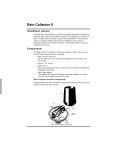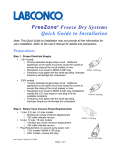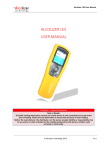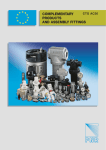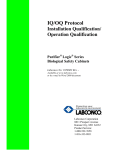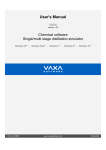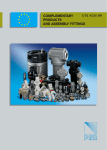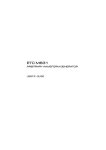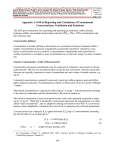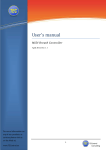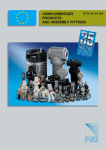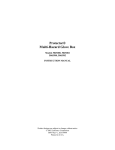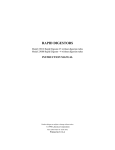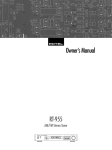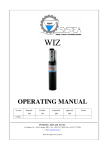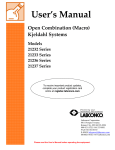Download RapidStill II User`s Manual
Transcript
RapidStill II MODEL 65200 INSTRUCTION MANUAL Product designs are subject to change without notice © 2002 Labconco Corporation 65441 REV. B / ECO A631 Printed in U.S.A. TABLE OF CONTENTS Preface Introduction Components Shipped General Description Performance Component Identification Installation Location Electrical Connection Water Connection Drain Connection NaOH Pump Connection Optional Water Inlet Kit Rear View of Standard RapidStill II Rear View of RapidStill II w/Optional Water Inlet Kit Installed Safety Precautions 1 2 3 4 4 10 10 10 11 11 12 13 14 15 Normal Operation Standard Operating Procedure 16 Routine Maintenance 17 Expendables 18 Cleaning 19 Servicing the RapidStill II Fuse Replacement Removing the Boiler Heating Element Replacement Condenser Extension Replacement Timer Replacement NaOH System Service 20 20 21 21 22 22 Replacement Parts 24 Dimensions 26 TABLE OF CONTENTS Specifications 27 Wiring Diagram 28 Troubleshooting 29 References 31 Warranty 32 Shipping Claims 33 Accessories 34 Contacting Labconco 35 INTRODUCTION Components Shipped Carefully check the contents of the carton for damage that might have occurred in transit. Do not discard the carton or packaging material until all components have been checked against the following component list and the equipment has been installed and tested. As shipped, the carton should contain the following: Part Number Description 65200 RapidStill II 65441 Instruction Manual Installation Kit (Contains hoses and fittings) 1 INTRODUCTION General Description The Labconco RapidStill II is designed specifically for the determination of macro concentrations of nitrogen. The RapidStill II performs rapid steam distillation from sulfuric acid digest prepared from nitrogen-bearing materials such as food products, feeds, grains, soils, plant tissue, wastewater effluent, organic wastes, etc. Sample digestions are accomplished using Labconco’s Rapid Digestor systems, described in the Accessories section of this manual. Figure 1 2 INTRODUCTION Performance The RapidStill II produces steam by heating a 1 liter flask (boiler) with a 1200 watt heating element. Activation of the heater, the addition of water to the boiler, and the addition of NaOH to the sample are all controlled by switches on the front control panel of the unit. An electric timer on the control panel allows the distillation time to be set from 0 to 15 minutes. Typical distillation times range from 5 to 10 minutes. 3 INTRODUCTION Component Identification (Figure 2) (1) Boiler Water Switch. This momentary contact switch fills the boiler with water. It is interlocked to prevent its operation during the heating of the boiler. Water should never be added to the boiler when it is hot and low on water (less than ¼ full) or dry. Allow the boiler to cool before adding water. (2) Boiler Heater Switch. The boiler heater switch activates the boiler heating element. The Boiler Heater should never be turned on when the boiler is dry or low on water. (3) NaOH Addition Switch. This momentary contact switch activates the NaOH pump to pump caustic from a user-supplied vessel into the digestion tube. The switch is interlocked to operate only when the boiler heater is on. At the end of every day, the NaOH pump lines must be rinsed with purified water. (4) Digestion Tube Clamping Device. The clamping device quickly and securely locates the digestion tube against the connection stopper. (5) Safety Door. The safety door surrounds the digestion tube and is designed to protect the operator. The door should always be in the closed position during operation of the RapidStill II. (6) NaOH Delivery Tube. This tube is used to dispense the user-supplied caustic directly into the digestion tube. (7) Connection Stopper. The Viton* stopper located on the bottom of the distribution head seals the digestion tube to the head. The connection stopper should be inspected and cleaned after every operating session of the unit. (8) Distribution Head. This distribution head acts as a junction for the steam and NaOH delivery tubes. The central part of the distribution head acts as a trap by preventing the NaOH from entering the receiving flask. (9) Steam Inlet Tube. The steam inlet tube is PTFE (Teflon*) and dispenses steam directly into the digestion tube. *Viton is a registered trademark of E.I. Du Pont de Nemours & Co. *Teflon is a registered trademark of E.I. Du Pont de Nemours & Co. 4 INTRODUCTION Component Identification Figure 2 5 INTRODUCTION Component Identification (Figure 3) (10) Condenser Extension. The condenser extension is a replaceable glassware fitting that connects the condenser and distribution head. (11) Condenser. The RapidStill II is equipped with a combined Allihn and spiral condenser for efficient recovery of the distillate. (12) Ventilation Valve. The ventilation valve prevents the distillate from being aspirated back into the condenser after the distillation is completed. If the valve sticks closed, remove it and wash out any material accumulated inside the valve. (13) Safety Screen. The plastic safety screen is designed to protect the operator. The screen should always be in the closed position during operation of the RapidStill II. (14) Boiler Viewing Slot. Looking through this slot the operator can easily inspect the water level in the boiler. Low and high water level marks are on the boiler flask to ease the inspection and addition operations. (15) Distillate Outlet Tube. This tube carries distillate from the condenser to the solution in the receiving flask. The bulb of the tube must be totally immersed in the receiving solution. (16) Distillation Timer Switch. The infinitely adjustable 0-15 minute timer controls the dispensing of steam into the digestion tube. It is interlocked to function only when the boiler heater is on. As an additional safety measure, NaOH cannot be dispensed into the digestion tube when the timer is in operation. (17) Spillage Tray. The spillage tray is designed to collect spilled reagents and overflow. The tray is removable and may be cleaned with ordinary soap and water. 6 INTRODUCTION Component Identification Figure 3 7 INTRODUCTION Component Identification (Figure 4) (18) Heater Cup Assembly. The heater cup assembly consists of the heater cup to support the boiler, and the heating element itself. (19) Boiler. The 1 liter boiler contains the boiling water that is the source of steam for the distillation. (20) Water Fill Valve. The valve dispenses water into the boiler when it is energized. The inlet of the valve is equipped with a filter screen, to prevent fouling with particulate matter. (21) Plastic Check Valves. These valves function as vacuum breaks, preventing negative pressurization of the system after it is shut off. (22) Steam Control Valve. The steam control valve directs steam from the boiler to the drain pipe during standby, or the steam delivery tube during distillation. The valve is controlled by the timer switch. (23) Drain Pipe. The drain pipe acts as a condenser for the steam not used in the distillation and as a drain for the condenser cooling water. DO NOT restrict the discharge from the drain pipe or its hose. The RapidStill II may be damaged by high water pressure. (24) Flow Restrictor. The flow restrictor prevents the cooling water flow rate from exceeding 1.0 gallon per minute. This minimizes water usage and prevents damage to the unit. (25) NaOH Pump. The peristaltic pump dispenses a user-supplied caustic solution from its container directly into the digestion tube. The pump inlet and outlet are equipped with quick connects to reduce the possibility of spillage during maintenance. The pump must be rinsed with purified water at the end of every work day to prevent damage to the pump or its fittings. (26) Water Inlet Fitting. The water inlet fitting is a push-on style fitting designed to connect tot the feed water line supplied in the installation kit. (27) Electrical Connector. The electrical connector mates with the power cord supplied in the installation kit. (28) Fuse. The 15 amp fuse protects the RapidStill II from an electrical overload. Replace this fuse with the appropriate replacement part. NEVER attempt to install a fuse with a higher amperage rating. 8 INTRODUCTION Component Identification Figure 4 9 INSTALLATION Location The RapidStill II should be located on a level work surface, adjacent to appropriate electrical, water and drain connections. Electrical Connection The electrical outlet should be rated for 115 VAC, 60 Hz, 15 Amps, and dedicated to the RapidStill II. Water Connection The feed water should be municipal drinking water grade and of sufficient quality to prevent or minimize scaling of the boiler. The feed water should have a minimum supply volume of 1 gallon (3.8 liters) per minute, at 10 PSI. Using the supplied braided water line, connect the tube to the water inlet fitting on the rear of the RapidStill II as shown in Figure 4. To connect or disconnect the fittings, follow the instructions in Figure 5, below. If your feed water promotes excessive scaling of the boiler, or has high NH3 levels, you may wish to install the Optional Water Inlet Kit, part #65442, described on page 12. Figure 5 10 INSTALLATION Drain Connection Using the supplied molded drain hose, connect and clamp the hose to the drain outlet located at the bottom of the drain pipe. The drain hose should be routed to an appropriate drain system, rated for a minimum capacity of 2 gallons (7.6 liters) per minute. The RapidStill II’s drain pipe is designed for gravity drainage. The drain hose and all connections must be below the level of the drain pipe outlet. The drain hose connection to the drain system must meet all applicable local standards for drain connections. DO NOT restrict the drain hose or its connections. Restrictions of the drain line may produce a pressure buildup in the RapidStill II, resulting in damage to the unit and water leakage. NaOH Pump Connections Using either the silicone tubing supplied in the installation kit, or another acceptable type of tubing, connect the NaOH pump inlet quick connector to the tubing. Connect the connector to the pump inlet by pressing it straight in until the connector ‘clicks’ and locks in place. The connector can be removed by depressing the metal button on the body of the connector and pulling the connector straight out. Place the other end of the tubing into the user-supplied caustic container. Provisions should be made for the easy removal of the tube from the caustic container, and its placement into a container of purified water for rinsing of the system at the end of each work session. 11 INSTALLATION Optional Water Inlet Kit With the purchase and installation of the Optional Water Inlet Kit, part #65442, two separate water supplies may be used to feed the RapidStill II; ordinary tap water may be used to supply the condenser while purified water is fed to the boiler. To function properly, the purified water source must be capable of delivering 1 gallon (3.8 liters) per minute at a minimum of 5 PSI. The purified water supply pressure should not exceed 20 PSI. The kit is installed as follows: (1) Unplug the RapidStill II and disconnect the feed water and drain lines, so the unit can be turned around. (2) Turn the unit around and locate the water inlet fitting as shown in Figure 6. (3) Locate the optional water inlet hole just above the water inlet fitting, as shown in Figure 6. (4) Install the supplied bulkhead union in a manner similar to the water inlet fitting below it. DO NOT overtighten the nut on the bulkhead union; it may damage the fitting. (5) Remove the flow restrictor assembly from the T-shaped fitting. Discard the short length of rigid plastic tubing that runs from the outlet of the flow restrictor to the Tshaped fitting. (6) Disconnect the condenser inlet fitting from the T-shaped fitting, as shown in Figure 6. (7) Plug the flow restrictor outlet into the condenser inlet fitting, as shown in Figure 7. (8) Install the braided tube assembly supplied with the kit from the bulkhead union installed in Step #4 to the T-shaped fitting. (9) Install the supplied plug into the open port of the T-shaped fitting. (10) When completed, the installation should appear as shown in Figure 7. The upper bulkhead fitting (that was just installed) supplies the boiler with water and may be connected to a purified water source. The lower bulkhead fitting (the original fitting) will now supply only the condenser with cooling water and should remain connected to an appropriate supply of feed water (tap water). 12 INSTALLATION Rear View of Standard RapidStill II Figure 6 13 INSTALLATION Rear View of RapidStill II with Optional Water Inlet Kit Installed Figure 7 14 SAFETY PRECAUTIONS The disposal of substances used in connection with this equipment may be governed by various federal, state or local regulations. All users of this equipment are urged to become familiar with any regulations that apply in the user’s area concerning the dumping of waste materials in or upon water, land or air and to comply with such regulations. The RapidStill II should not be operated in damp conditions or those suspect of an explosion and should be situated to allow adequate room and ventilation during its normal usage. The RapidStill II employs the following: electrical devices, heating element, hot water, steam, pressurized water and steam lines. Care should be taken when installing, operating, or servicing the unit. Ensure that the RapidStill II is connected to electrical service in accordance to local and national electrical codes. Failure to do so may create a fire or electrical hazard. The RapidStill II is designed to be connected to a cold, potable water supply purified by municipal water treatment facilities. The installation of the optional water inlet kit allows for the use of purified water to supply the boiler. Never connect the RapidStill II to non-potable, unprocessed surface or well water systems. The use of inadequate water supplies may damage the unit. Always wear appropriate eye protection, protective gloves and clothing when using the RapidStill II. Never operate the RapidStill II without the Safety Screen and Safety Door in their proper position. Never turn on the boiler heater when the boiler flask is dry or low on water. Do not let the boiler run dry. Do not attempt to refill the boiler when it is dry or low on water and hot. Failure to ensure proper water level in the boiler, or attempting to fill it when hot may result in the breakage of the boiler flask and/or damage to the heating element. At then end of the day, rinse the caustic delivery system with purified water. Remove any accumulated spillage or deposits from the surfaces of the unit to prevent corrosion or damage. 15 NORMAL OPERATION Standard Procedure (1) Turn on the cooling water, allowing it to flow through the condenser. The flow rate will be regulated to 1 gallon per minute (3.8 liters per minute). (2) Depress the ‘Boiler Water’ switch. Looking through the Boiler viewing slot, fill the boiler approximately 2/3 full, or to the top line of the flask. If the boiler fills too slowly, slightly increase the flow rate of the cooling water supply. If the Optional Water Inlet Kit is installed and the boiler fills too slowly, increase the pressure or flow rate of the purified water supply. When the proper water level is obtained, release the switch. (3) Turn the ‘Boiler Heater’ switch to the ‘ON’ position. After approximately 10 minutes, or when the water in the boiler is at a steady boil, the unit is ready for operation. (4) Place the digestion tube with a digested sample in the RapidStill II, giving the tube a slight twist to assure a complete seal. (5) Place a receiver flask under the Distillate Outlet Tube. Make sure that the outlet tube is fully submerged. (6) Add NaOH solution to the digestions tube by depressing the ‘NaOH Addition’ switch. For each 5 ml of concentrated sulfuric acid used in the digestion process, add approximately 15 ml of 50% NaOH solution to make the distillation solution strongly alkaline. Use the graduated decal on the front panel of the RapidStill II as an approximate gauge of the volume in the digestion tube. (7) Turn the distillation Time switch to the desired time setting. Be sure to allow enough time for the distillation solution to reach boiling. (8) When the distillation is completed, the unit will return to a standby position, with the boiler heater still in operation. (9) Remove the digestion tube, using appropriate heat and chemically resistant gloves. (10) If there are to be additional distillations and the boiler water level is low, turn the ‘Boiler Heater’ switch off and depress the ‘Boiler Water’ switch on. Allow the boiler to refill with water, release the ‘Boiler Water’ switch and turn the ‘Boiler Heater’ switch on. When the water in the boiler resumes boiling, the RapidStill II is ready for another distillation. (11) Titrate the distillate in the receiving flask. If the temperature of the solution exceeds 120°F (50°C), check the flow rate of the condenser cooling water. 16 ROUTINE MAINTENANCE Under normal operation, your RapidStill II will require little routine maintenance. The following maintenance schedule is recommended: After Every Day (1) Rinse the caustic pump, its delivery system and the distribution head as follows: (a) Install a clean empty digestion tube in place. Remove the caustic supply tubing from the caustic vessel and place it in a vessel of purified water. (b) Turn on the cooling water and fill the boiler as described on page 16. (c) Turn on the boiler heater. (d) Depress ‘NaOH Addition’ switch and hold it on until all of the caustic has been purged out of the system and into the distillation tube. (e) Remove the digestion tube and dispose of the liquid appropriately. (f) Replace the digestion tube and fill it approximately half full by depressing the ‘NaOH Addition’ switch. (g) When the water in the boiler is at a rolling boil, turn the distillation timer to approximately 10 minutes. (h) At the end of the distillation cycle, turn the boiler heater and the cooling water off. Remove the digestion tube wearing appropriate heat and chemically resistant gloves. Dispose of the liquid appropriately. (2) Clean the exterior surfaces of the RapidStill II using a soft cloth and a solution of mild soap and water to remove any spilled chemicals or deposits. Weekly (1) Examine the boiler for any build up of deposits. Accumulate deposits in the boiler may be removed by dilute solution of hydrochloric acid, or by using commercially available descaling solutions that are compatible with glass. USE APPROPRIATE PROTECTIVE SAFETY EQUIPMENT WHEN HANDLING CLEANING SOLUTIONS. ALWAYS FOLLOW THE CLEANING SOLUTION INSTRUCTIONS REGARDING THEIR USE, SAFETY PRECAUTIONS TO BE FOLLOWED, AND DISPOSAL. For instructions on how to remove the boiler, refer to ‘Removing the Boiler’ in the Service section of this manual on page 20. (2) Examine all plumbing and steam lines, ensuring that the tubing is intact. Examine all tubing connections. Examine the connection stopper for deterioration or cracking. 17 EXPENDABLES The following is a brief list of replacement parts: PART NO. DESCRIPTION 13444 Fuse, 15 Amp 65230 Boiler Flask 65394 Heating Element 65436 Condenser Extension 13594 Plastic Check Valve 13022 Switch, Rocker DPDT 13033 Switch, Rocker Momentary Contact 16240 Tubing, Silicone, 1/2 x 5/16 inch (ordered by the foot) 16241 Tubing, Silicone, 9/32 x 5/32 inch (ordered by the foot) 65448 Peristaltic Pump Tube 65206 Cap # GL 18 with gasket 65212 Cap # GL 32 with gasket 18 CLEANING Every day the caustic pump, delivery system and distribution head should be cleaned as described in the ‘ROUTINE MAINTENANCE’ section of this manual. Accumulated deposits or scale in the boiler may be removed by removing the boiler and washing it with a dilute solution of hydrochloric acid or a commercially available scale remover that is compatible with glass. USE APPROPRIATE PROTECTIVE SAFETY EQUIPMENT WHEN HANDLING CLEANING SOLUTIONS. ALWAYS FOLLOW THE CLEANING SOLUTION INSTRUCTIONS REGARDING THEIR USE, SAFETY PRECAUTIONS TO BE FOLLOWED AND DISPOSAL. For instruction on how to remove the boiler, refer to the ‘Removing the Boiler’ in the ‘SERVICE’ section of this manual. The exterior of the unit should also be cleaned after each work session using a soft cloth and a solution of mild soap and water to prevent the accumulation of deposits. 19 SERVICING THE RAPIDSTILL II Fuse Replacement (1) Unplug the unit from electrical service. (2) Using a small screwdriver or coin, turn the slotted fuse holder ¼ turn counterclockwise. (3) Pull the fuse and holder straight out. Remove the fuse from its holder by pulling the fuse straight out. Replace the fuse with a proper replacement part only. DO NOT attempt to replace the fuse with one of a higher amperage rating. (4) To reinstall the fuse, reverse the above steps. Removing the Boiler (1) Unplug the RapidStill II from electrical service. (2) Turn the unit around to gain access to the boiler flask. (3) Remove the head of the boiler by pulling it straight up. If the head is stuck onto the boiler, apply water to the joint to loosen it. (4) Pull the ring that secures the boiler straight up until it clears the neck of the boiler flask. The boiler can now be removed. (5) To reinstall the boiler, reverse the above steps. 20 SERVICING THE RAPIDSTILL II Heating Element Replacement (1) Unplug the RapidStill II. (2) Remove the boiler as described on page 20. (3) Remove the perforated screen surrounding the heating element by removing the three screws that secure it. (4) Disconnect the two heating element wires from the wiring harness by pulling the electrical connectors straight apart. Remove the ground wire from the bottom of the heater cup by pulling the wire straight down. (5) Remove the four nuts and lockwashers that secure the heating element cup and its platform to the frame of the RapidStill II. (6) Pull the heating element cup and its platform straight away from the frame. (7) Remove the heating element cup from its platform by removing the three screws on the underside of the cup. (8) Remove the heating element from the cup by removing the two heating element bulkhead nuts located on the bottom of the cup. Pull the element and its wires straight out of the cup. (9) Install the new element by reversing the above steps. Condenser Extension Replacement (1) Rotate the safety screen assembly up until it is fully open. (2) Loosen the knurled nut that secures the condenser extension to the distribution head. Remove the plastic clamp that connects the extension to the condenser. (3) While supporting the condenser, use a Phillips screwdriver to remove the screws that secure the condenser bracket straps to the condenser bracket. (4) Rotating the condenser out of the way, pull the extension straight out of the distribution head. (5) Remove the knurled nut and its sealing ring from the old extension tube, and install it on the new tube, noting the correct orientation of the nut and washer. (6) Install the new extension tube, orienting the drip point of the tube to the bottom. Reverse steps 1-4 to complete the installation. 21 SERVICING THE RAPIDSTILL II Timer Replacement (1) Unplug the RapidStill II from electrical service. (2) Remove the four screws that secure the front panel on the base of the unit and pull the panel straight out. (3) Using an allen wrench, loosen the two set screws that secure the timer knob on its shaft. Pull the knob straight off. (4) Disconnect the electrical connections on the timer, noting the terminals’ orientation. (5) Using the proper wrench, loosen the hex nut that secures the timer to the front panel and pull the timer out of the panel. (6) Install the new timer by reversing the above steps. NaOH System Service The tubing in the NaOH delivery system should not require replacement if properly rinsed after each work session. To replace the peristaltic pump tube, proceed as follows: (1) If possible, purge the NaOH delivery system and peristaltic pump with purified water, as described in the Routine Maintenance section on page 17. (2) Unplug the RapidStill II from electrical service. (3) Turn the unit around to gain access to the peristaltic pump. (4) Remove the four small Phillips screws as shown in Figure 8. (5) Remove the pump cover, exposing the pump tube. (6) Pull the pump tube straight out of the pump housing. (7) Thoroughly rinse the tube and remove the pump fittings and clamps. Retain the fittings and clamps for use on the new tube. (8) Install the new tube by reversing the above steps. 22 SERVICING THE RAPIDSTILL II Figure 8 23 REPLACEMENT PARTS ITEM QTY. 1 2 3 4 5 6 7 8 9 10 11 12 1 1 1 1 2 1 1 1 1 1 1 1 PART NO. DESCRIPTION 65394 65230 65416 65435 13594 13635 44115 16240 16241 65388 65448 13444 Heating Element Boiling Flask Boiler Head Balance Tee Plastic Check Valve Steam Control Valve Water Fill Valve Tubing, Silicone, 1/2 x 5/16 inch Tubing, Silicone, 9/32 x 5/32 inch Flow Restrictor Assembly Peristaltic Pump Tube Fuse, 15 Amp Figure 9 24 REPLACEMENT PARTS ITEM QTY. 13 14 15 16 17 18 19 20 21 22 23 24 2 1 1 2 1 1 1 1 1 1 1 1 PART NO. DESCRIPTION 13033 13022 65229 65206 65207 65203 65212 65436 65410 65213 2128801 65434 Switch, Momentary Contact Switch DPDT Connection Stopper Cap # GL 18 with gasket Dispensing Tube – NaOH Distribution Head Cap # GL 32 with gasket Condenser Extension Condenser Ventilation Valve Distillation Outlet Tube Timer Assembly Figure 10 25 DIMENSIONS Figure 11 26 SPECIFICATIONS Electrical Requirements: 115 VAC, 15 Amps, 60 Hz, single phase Heating Element: 1200 Watt, 115 VAC Boiler Capacity: 1 liter total volume, 750 ml operating volume Condenser Flow Rate: 1 gallon per minute (3.8 liters per minute) Timer: 0-15 minutes, infinitely adjustable 27 WIRING DIAGRAM Figure 12 28 TROUBLESHOOTING PROBLEM CAUSES CORRECTIVE ACTION Unit will not operate at all Tripped circuit breaker Check facility’s circuit breaker Blown fuse Replace fuse Power cord not plugged in Plug in cord ‘Boiler Heater’ switch is on Turn off boiler heater before filling Cooling water off or flow rate insufficient Check flow rate of condenser cooling water Water fill valve plugged or defective Clean inlet screen of filter; replace valve ‘Boiler Water’ switch defective Replace switch Heating element is defective Replace heating element ‘Boiler Heater’ switch is defective Replace switch ‘Boiler Heater’ switch is off The boiler heater must be on for the NaOH pump to operate Boiler doesn’t fill Heating element doesn’t work NaOH pump doesn’t run Distillation Timer is set in The Distillation timer must be the timing mode set to ‘0’ for the NaOH pump to work NaOH pump runs, but doesn’t pump NaOH pump is defective Replace the NaOH pump NaOH tube is kinked or restricted Check all lines for kinks or blockage Peristaltic pump tube damaged Replace peristaltic pump tube Peristaltic pump is damaged Replace peristaltic pump 29 TROUBLESHOOTING PROBLEM CAUSES CORRECTIVE ACTION Water is noisy when flowing through the unit Excessive water flow rate Reduce the water flow rate slightly Steam drains erratically; steam valve is noisy during standby Drain hose is kinked or elevated above the drain pipe Drain hose must flow unrestricted to a drain below the drain pipe Boiling flask breaks Flask has gone dry Do not let flask go dry Water added when boiler Do not add water to the boiler is dry or low on water and when it is hot and dry, or low on hot water Recoveries are low Recoveries are too high Viton seal is leaking Clean/replace the Viton seal Receiving tube is not completely submerged The receiving tube must be completely submerged in the receiving vessel Not collecting enough distillate Increase distillation time Excessive NH3 in feed water Connect to a different water source; install Optional Water Inlet Kit #65442 and feed purified water to the boiler 30 REFERENCES Rapid Kjeldahl Methodology for the Determination of Nitrogen in Paper Products. 1993. Labconco Corporation, Kansas City, MO. Rapid Kjeldahl Methodology for the Determination of Total Kjeldahl Nitrogen in Water. 1993. Labconco Corporation, Kansas City, MO. Methodology for the Determination of Alcohol in a Mixture by Direct Distillation. 1993. Labconco Corporation, Kansas City, MO. Methodology for the Determination of Ammonia in Water by Direct Distillation. 1993. Labconco Corporation, Kansas City, MO. Rapid Kjeldahl Methodology for the Determination of Nitrogen in Meat Products. 1993. Labconco Corporation, Kansas City, MO. Rapid Kjeldahl Methodology for the Determination of Nitrogen in Feeds, Foods, Grains, Cereals, and Grasses. 1993. Labconco Corporation, Kansas City, MO. Rapid Kjeldahl Methodology for the Determination of Protein Content in Milk. 1993. Labconco Corporation, Kansas City, MO. 31 WARRANTY We are committed to providing our customers with quality equipment and service after the sale. Part of this objective involves keeping you informed of changes and new product additions. We, therefore, request that you take a moment to fill out the product registration card so we many know your location as well as some of the reasons that prompted you to purchase our product. Labconco provides a warranty on all parts and factory workmanship. The warranty includes areas of defective material and workmanship, provided such defect results from normal and proper use of the equipment. The warranty for all Labconco products will expire one year from date of installation or two years from date of shipment from Labconco, whichever is sooner, except the following: • • • Purifier® Delta® Series Biological Safety Cabinets carry a three-year warranty from date of installation or four years from date of shipment from Labconco, whichever is sooner. Carts carry a lifetime warranty. Glassware is not warranted from breakage when dropped or mishandled. This limited warranty covers parts and labor, but not transportation and insurance charges. In the event of a warranty claim, contact Labconco Corporation or the dealer who sold you the product. If the cause is determined to be a manufacturing fault, the dealer or Labconco Corporation will repair or replace all defective parts to restore the unit to operation. Under no circumstances shall Labconco Corporation be liable for indirect, consequential, or special damages of any kind. This statement may be altered by a specific published amendment. No individual has authorization to alter the provisions of this warranty policy or its amendments. Lamps and filters are not covered by this warranty. Damage due to corrosion or accidental breakage is also not covered. WARNING: The disposal and/or emission of substances used in connection with this equipment may be governed by various federal, state or local regulations. All users of this equipment are urged to become familiar with any regulations that apply in the user’s area concerning the dumping of waste materials in or upon water, land or air and to comply with such regulations. 32 SHIPPING CLAIMS If shipment is received in visibly damaged condition, be certain to make a notation on the delivering carrier’s receipt and have his agent confirm the damage on your receipt. Otherwise, the damage claim may be refused. If concealed damage or pilferage is discovered, notify the carrier immediately and retain the entire shipment intact for inspection. Interstate Commerce Commission rules require that the claim be filed with the carrier within 15 days after delivery. NOTE: Do not return goods. Goods returned without prior authorization will not be accepted. Labconco Corporation and its dealers are not responsible for shipping damage. Claims must be filed directly with the freight carrier by the recipient. If authorization has been received to return this product, by accepting this approval, the user assumes all responsibility and liability for biological and chemical decontamination and cleansing. Labconco reserves the right to refuse delivery of any products which do not appear to have been properly cleaned and/or decontaminated prior to return. 33 ACCESSORIES Accessory Part # Description 23080 Rapid Digestor - 4 Temperature control unit with indicator light, adjustable from ambient to 450°C and 4-place digestion unit designed for 250 ml digestion tubes (not included). 23012 Rapid Digestor - 25 Temperature control unit with light, adjustable from ambient to 450° and 25-place digestion unit designed for 250 ml digestion tubes (not included). 23540 4-Place Fume Removal System Borosilicate glass manifold with 4 eductors designed to rest atop the digestion tubes. A water aspirator (not included) is required. 2350025 25-Place Fume Removal System Borosilicate glass manifold with 25 eductors designed to rest atop the digestion tubes. A water aspirator for 40 PSI water pressure is included. 2304005 Straight Digestion Tube – Package of 5 Made of borosilicate glass with heavy retention lip and round bottom. 2304025 Straight Digestion Tube – Package of 25 Made of borosilicate glass with heavy retention lip and round bottom. 2303005 Volumetric Digestion Tube – Package of 5 Has an easy-to-read calibration mark at 250 ml and built-in construction for maximum refluxing and digestion speed. Made of borosilicate glass with heavy retention lip and round bottom. 2303025 Volumetric Digestion Tube – Package of 25 Has an easy-to-read calibration mark at 250 ml and built-in constriction for maximum refluxing and digestion speed. Made of borosilicate glass with heavy retention lip and round bottom. 65442 Optional Water Inlet Kit Allows the user to connect the condenser and the boiler to separate water supplies. 34 CONTACTING LABCONCO If you have any questions that are not addressed in this manual or if you need technical assistance, please contact Labconco’s Customer Service Department at 1-800-821-5525, Labconco’s Product Service Department at 1-800-522-7658 or either department at 1-816-333-8811, between the hours of 7:00 a.m. and 6:00 p.m. Central Standard Time. Labconco’s mailing address is: Labconco Corporation 8811 Prospect Avenue Kansas City, Missouri 64132-2696 Visit Labconco through the Internet at: http://www.labconco.com or e-mail: [email protected] 35







































